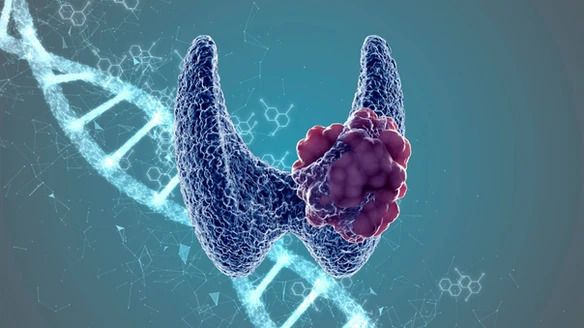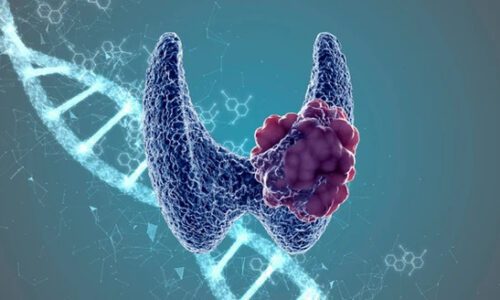- Marcos Santos, Ph.D
- 0 Comments
- 1361 Views
What is a thyroid nodule?
A thyroid nodule is a mass of cells that has grown or a fluid-filled cyst that forms in the thyroid gland. The condition is common and occurs more frequently as a person ages. Let’s understand how a thyroid nodule can affect the body.
I have a thyroid nodule, what happens now?
Although symptoms are not common, a large nodule can sometimes cause pain, hoarseness, swallowing or breathing difficulties. Physicians are concerned about a thyroid nodule because it can sometimes be cancer.

Thyroid cancer is found in about 8% of nodules in men and 4% in women. Thus, about 90% of thyroid nodules are benign (1). According to the American Cancer Society, the cause of most benign thyroid nodules is unknown, but they are often found in members of the same family. Worldwide, iodine deficiency in the diet is a very common cause of the problem (2). How can you determine if a thyroid nodule is benign or malignant? There are some differences identified in specific exams. Let’s understand then.
How is the type of thyroid nodule determined?
Most thyroid nodules are found during a routine physical examination. Once the problem is detected, the doctor will perform laboratory tests to determine if the nodule is hyperfunctioning (producing too much thyroid hormone) or hypofunctioning (not producing thyroid hormone or produce in small quantities). However, these tests alone are not sufficient to rule out thyroid cancer. To gather more information about the nodule, the doctor may request one or more of the following exams (1):
- Thyroid ultrasound: This is performed to get an accurate picture of the thyroid and see if the nodule is solid or filled with fluid (cyst). Although this exam cannot guarantee whether the nodule is malignant or benign, it is very useful in guiding fine-needle aspiration biopsy.
- Fine-needle aspiration biopsy (FNA): A thin needle is used to remove cells or fluid samples from the nodule. This test is very useful for identifying benign, cancerous, or suspicious nodules.
What indicates whether a thyroid nodule is benign or malignant?
It is the ultrasound characteristics of the nodule that determine whether it is malignant or benign and whether a fine-needle aspiration biopsy (FNA) is necessary. The result of the FNA is categorized according to the Bethesda System for Reporting Thyroid Cytopathology, with the following correlation between diagnostic category and clinical interpretation (3):
| Diagnostic Category | Meaning |
| I | Non-diagnostic sample |
| II | Benign |
| III – indeterminate | Atypic/Follicular Lesion of Undetermined Significance |
| IV – indeterminate | Suspicious for Follicular Neoplasm or Follicular Neoplasm |
| V | Suspicious for Malignancy |
| VI | Malignant |
The FNA report usually indicates one of the following findings:
The nodule is benign (non-cancerous):
This result is obtained in up to 60% of biopsies. Generally, benign thyroid nodules do not need to be removed unless they are causing symptoms such as difficulty breathing, swallowing, or cosmetic concerns. If the nodule causes symptoms, a non-surgical treatment option is Radiofrequency Ablation.
The nodule is malignant (cancerous) or suspicious for malignancy:
This result is obtained in about 7% of biopsies and is mostly due to papillary carcinoma, which is the most common type of thyroid cancer. These diagnoses usually require surgical removal of the thyroid. However, new treatments are being studied and evaluated, such as Radiofrequency Ablation and Active Surveillance.
The nodule is indeterminate (Bethesda III or IV):
This diagnosis can occur in up to 30% of cases and means that even though an adequate number of cells were removed during the FNA, the microscopic examination cannot reliably classify the result as either benign or malignant (cancer). These nodules are cancerous in only 20-30% of cases (2).
A common approach suggests that the accurate diagnosis of an indeterminate thyroid nodule can only be made through surgery. The procedure involves removing only the side of the thyroid with the nodule or the entire gland. However, this may be unnecessary as the vast majority of these nodules are benign (almost 80%!). Here’s how such a radical approach can be avoided.
How to avoid unnecessary surgery?
Up to 84% of indeterminate thyroid nodules undergoing surgery are reclassified as benign after surgery (4). Avoiding unnecessary surgical procedures is always recommended. After all, no matter how simple it may be, every surgery carries risks.
In the case of a thyroid nodule with an indeterminate diagnosis, molecular tests that utilize artificial intelligence are already available. The mir-THYpe was developed by Onkos in partnership with the Barretos Cancer Hospital, a reference in the diagnosis and treatment of thyroid tumors in Latin America. It uses artificial intelligence to robustly and reliably diagnose the nature of the thyroid nodule.
The doctor’s approach to a negative result in the molecular test is similar to a benign result in the FNA: there is usually no need for surgery, and the nodule can be monitored. When the result is positive, prognostic markers can predict more or less aggressive behavior, helping to personalize surgery extension. It is a a more personalized and less subjective technique.
If you are in this condition, it is worth getting to know and discussing this possibility with your doctor!
References:
- American Thyroid Association. https://www.thyroid.org/thyroid-nodules/
- American Cancer Society. https://www.cancer.org/cancer/thyroid-cancer/about/what-is-thyroid-cancer.html
- Ministério da Saúde. https://aps.bvs.br/aps/como-proceder-diante-do-resultado-citologico-da-puncao-aspirativa-por-agulha-fina-paaf-de-um-nodulo-tireoidiano/
- Bongiovanni M, et al. 2012 Acta Cytologica







